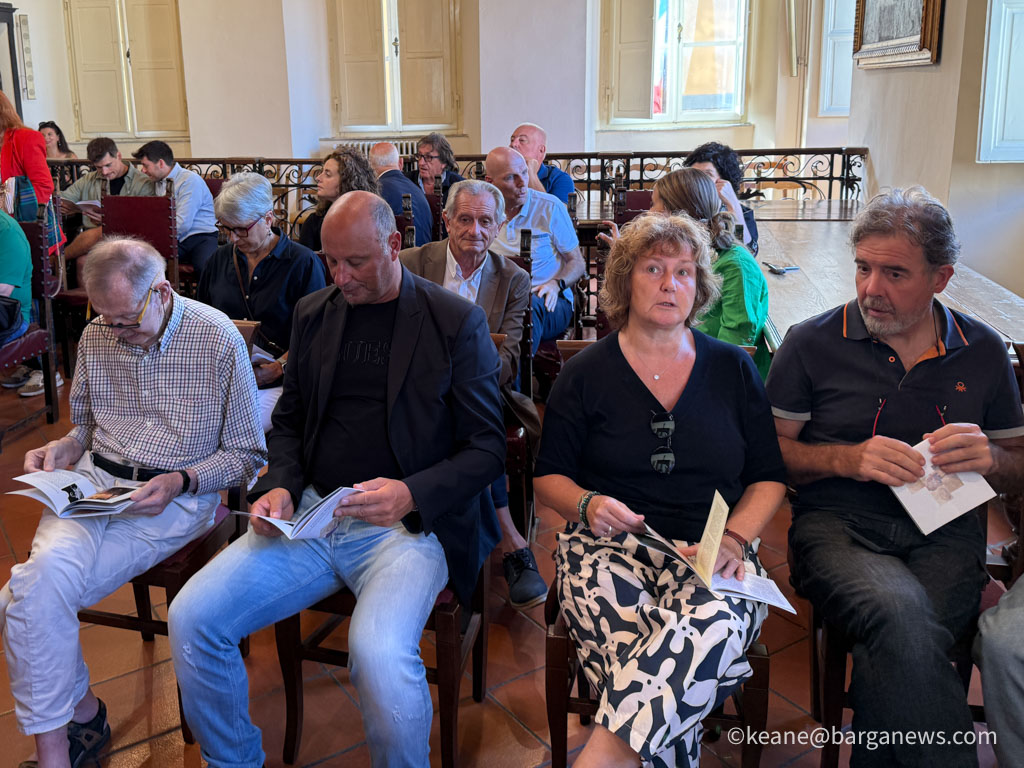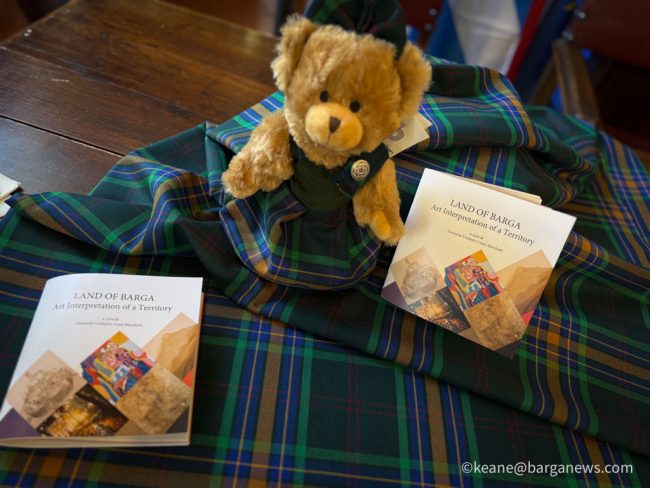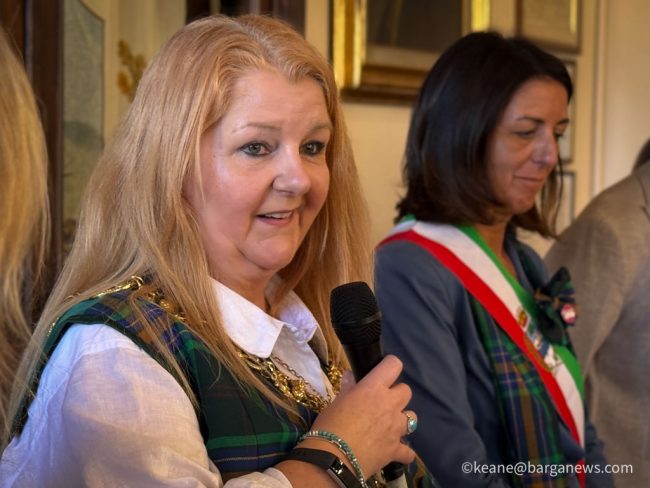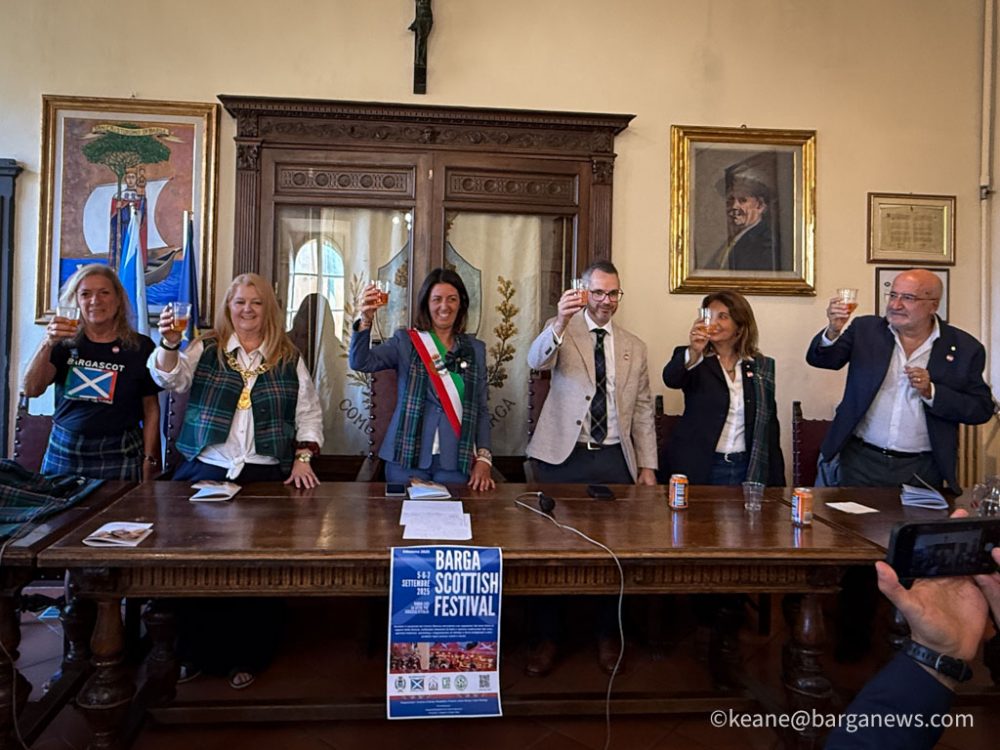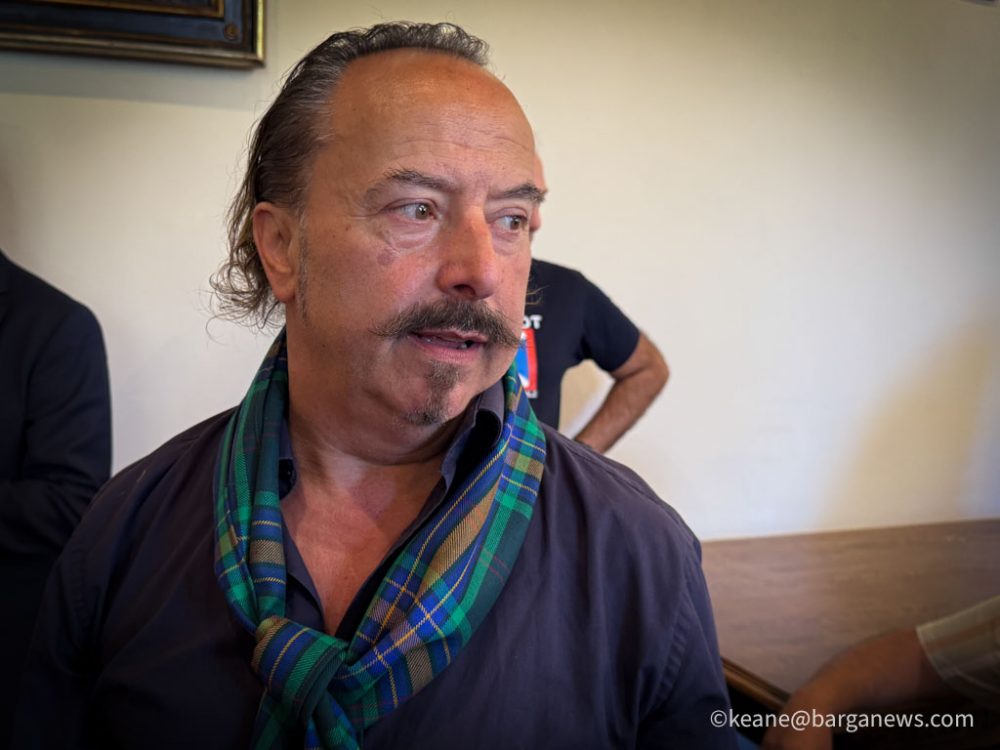Presentation this morning in the Palazzo Pancrazi with the Mayor of Barga Caterina Campani and the Lord Provost of Glasgow, Jacqueline McLaren, of the Barga – Glasgow friendship tartan from the Barga-Scottish producer Michael Lemetti and also to present the five artists who will be showing their work later this year at the Exhibition “Land of Barga” in Glasgow Scotland.
Swietlan Nicholas Kraczyna | Sandra Rigali | Keane | Fabrizio Da Prato | Emanuele Biagioni
Barga is a city perched on the hills in the verdant heart of the Serchio Valley, framed by the imposing peaks of the Apuan Alps and the Tuscan-Emilian Apennines. Its privileged position offers breathtaking views and a timeless atmosphere that has enchanted generations of visitors — including the renowned poet Giovanni Pascoli, who chose to live here and called this place the homeland of his work. The origins of Barga are deeply rooted in ancient history: while archaeological findings attest to the presence of the Ligurian Apuans and the Romans, it was the Lombards who founded the actual settlement, as suggested by the etymology of the name, derived from the Germanic term “Berg,” meaning a place situated at a height.
In the Middle Ages, thanks to its strategic position as a crossroads between the Po Valley and Tuscany, Barga became a coveted center, contested by the powers of Lucca and Pisa. It was Matilda of Canossa who granted it its first fiscal privileges, later confirmed by Frederick Barbarossa.
In 1342, the town made a farsighted decision: it voluntarily submitted to the Republic of Florence, gaining military protection and economic advantages without giving up its autonomy. Thus, Barga remained a Florentine enclave between the Republic of Lucca and the Este fiefdoms for five centuries, until the eve of Italian unification.
This unique bond with Florence is still visible today in its society, economy, religious life, and architectural and artistic heritage. (consider, for example, the many Della Robbia altarpieces found in the town).
In all this, Barga stands apart from the other villages of the Serchio Valley: it feels almost like a small capital, a piece of city nestled among the mountains, where the compact and well-defined urban space has been perfectly preserved through the centuries.
Paradoxically, Italian unification had a negative effect on the area: with the loss of its fiscal privileges as a borderland, Barga experienced a sudden economic decline. In fact, between the 19th and 20th centuries, strong waves of emigration departed from here, especially to the United States and Great Britain. It was precisely during this period, between the late 1800s and early 1900s, that the poet Giovanni Pascoli chose Barga as his place of residence.
Pascoli lived in the nearby hamlet of Castelvecchio for nearly twenty years, drawing inspiration from the land and its people in his poetry. Casa Pascoli, now open to visitors as a museum, offers a unique experience — a journey back in time, as it has remained exactly as it was when the poet lived there. Throughout the 20th century, Barga continued its existence without major upheavals, except during World War II, when it found itself on the Gothic Line.
Numerous traces of this dramatic chapter remain, especially in the mountain village of Sommocolonia, the epicentre of the bloody Christmas battle of 1944. Today, Barga presents itself as a lively and welcoming village, included among the “Most Beautiful Villages in Italy” and awarded the Orange Flag by the Italian Touring Club. Its historic center, rich in picturesque views, monuments, and traditions, offers a perfect balance between provincial tranquility and a strong cultural and touristic vocation.
Barga is not just a destination to visit — it is a place to live, to listen to, to breathe — just as Pascoli did, letting himself be captivated by its authentic and timeless beauty. – Sara Moscardini
Presentazione questa mattina a Palazzo Pancrazi, con la sindaca di Barga, Caterina Campani, e la Lord Provost di Glasgow, Jacqueline McLaren, del tartan dell’amicizia Barga–Glasgow del produttore bargo-scozzese Michael Lemetti e, inoltre, presentazione dei cinque artisti che esporranno le loro opere più avanti quest’anno alla mostra “Land of Barga” a Glasgow, Scozia.
Swietlan Nicholas Kraczyna | Sandra Rigali | Keane | Fabrizio Da Prato | Emanuele Biagioni
Barga è una città arroccata sulle colline nel cuore verde della Valle del Serchio, incorniciata dalle imponenti vette delle Alpi Apuane e dell’Appennino tosco-emiliano.
La sua posizione privilegiata offre scorci mozzafiato e un’atmosfera senza tempo che ha incantato generazioni di visitatori — tra cui il celebre poeta Giovanni Pascoli, che scelse di vivere qui e definì questo luogo la patria della sua poesia. Le origini di Barga affondano in una storia antichissima: se i ritrovamenti archeologici attestano la presenza dei Liguri Apuani e dei Romani, furono i Longobardi a fondare il vero e proprio insediamento, come suggerisce l’etimologia del nome, derivato dal termine germanico “Berg”, che indica un luogo situato in altura.
Nel Medioevo, grazie alla sua posizione strategica come crocevia tra la Pianura Padana e la Toscana, Barga divenne un centro ambito, conteso tra i poteri di Lucca e Pisa. Fu Matilde di Canossa a concederle i primi privilegi fiscali, poi confermati da Federico Barbarossa. Nel 1342 la città compì una scelta lungimirante: si sottomise volontariamente alla Repubblica di Firenze, ottenendo protezione militare e vantaggi economici senza rinunciare alla propria autonomia. Così, per cinque secoli, Barga rimase un’enclave fiorentina tra la Repubblica di Lucca e i feudi estensi, fino alle soglie dell’Unità d’Italia.
Questo legame unico con Firenze è ancora oggi visibile nella società, nell’economia, nella vita religiosa e nel patrimonio architettonico e artistico (si pensi, ad esempio, alle numerose terracotte invetriate dei Della Robbia presenti in città). In tutto questo, Barga si distingue dagli altri centri della Valle del Serchio: appare quasi come una piccola capitale, un frammento di città incastonato tra le montagne, dove il tessuto urbano compatto e ben definito si è conservato perfettamente nei secoli. Paradossalmente, l’Unità d’Italia ebbe un effetto negativo sull’area: con la perdita dei privilegi fiscali di terra di confine, Barga conobbe un improvviso declino economico.
Tra Ottocento e Novecento partirono da qui forti ondate migratorie, soprattutto verso gli Stati Uniti e la Gran Bretagna. Fu proprio in questo periodo, tra fine Ottocento e inizi Novecento, che il poeta Giovanni Pascoli scelse Barga come luogo di vita. Pascoli abitò per quasi vent’anni nella vicina frazione di Castelvecchio, traendo ispirazione da questa terra e dalla sua gente per la sua poesia. Casa Pascoli, oggi visitabile come museo, offre un’esperienza unica — un viag
gio nel tempo, poiché è rimasta esattamente com’era quando il poeta vi abitava. Nel corso del Novecento, Barga proseguì la propria esistenza senza grandi sconvolgimenti, salvo durante la Seconda guerra mondiale, quando si trovò sulla Linea Gotica. Numerose sono le tracce di quel drammatico capitolo, soprattutto nel borgo montano di Sommocolonia, epicentro della sanguinosa battaglia di Natale del 1944. Oggi
Barga si presenta come una città vivace e accogliente, inserita tra “I Borghi più belli d’Italia” e insignita della Bandiera Arancione del Touring Club Italiano. Il suo centro storico, ricco di scorci, monumenti e tradizioni, offre un equilibrio perfetto tra tranquillità e una forte vocazione culturale e turistica.
Barga non è solo una meta da visitare — è un luogo da vivere, da ascoltare, da respirare — proprio come fece Pascoli, lasciandosi conquistare dalla sua bellezza autentica e senza tempo. – Sara Moscardini





